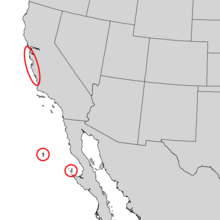| Monterey pine | |
|---|---|

| |
| Scientific classification | |
| Kingdom: | Plantae |
| Clade: | Tracheophytes |
| Clade: | Gymnospermae |
| Division: | Pinophyta |
| Class: | Pinopsida |
| Order: | Pinales |
| Family: | Pinaceae |
| Genus: | Pinus |
| Subgenus: | P. subg. Pinus |
| Section: | P. sect. Trifoliae |
| Subsection: | P. subsect. Australes |
| Species: | P. radiata
|
| Binomial name | |
| Pinus radiata | |

| |
| Natural range of Pinus radiata | |
Pinus radiata (syn. Pinus insignis), the Monterey pine,[3] insignis pine[4] or radiata pine, is a species of pine native to the Central Coast of California and Mexico (on Guadalupe Island and Cedros island). It is an evergreen conifer in the family Pinaceae.
P. radiata is a versatile, fast-growing, medium-density softwood, suitable for a wide range of uses and valued for rapid growth, as well as desirable lumber and pulp qualities.[5] Its silviculture reflects a century of research, observation and practice.[5] It is often considered a model for growers of other plantation species.[5]
Although P. radiata is extensively cultivated as a plantation timber in many temperate parts of the world,[6] it faces serious threats in its natural range,[7] due to the introduction of a fungal parasite, the pine pitch canker (Fusarium circinatum).
- ^ Farjon, A. 2013. Pinus radiata. In: IUCN 2013. IUCN Red List of Threatened Species. Version 2013.1. www.iucnredlist.org. Downloaded on 13 July 2013.
- ^ "NatureServe Explorer 2.0".
- ^ BSBI List 2007 (xls). Botanical Society of Britain and Ireland. Archived from the original (xls) on 26 June 2015. Retrieved 17 October 2014.
- ^ Kershner, Bruce; et al. (2008). National Wildlife Federation Field Guide to Trees of North America. New York: Sterling. p. 84. ISBN 978-1-4027-3875-3.
- ^ a b c Mead, D (2013). Sustainable management of Pinus radiata. Rome: Food and Agriculture Organization of the United Nations. ISBN 978-92-5-107634-7.
- ^ Earle, Christopher J., ed. (2018). "Pinus radiata". The Gymnosperm Database.
- ^ "Status of Native Monterey Pine (Pinus radiata) Ecosystems" (PDF).

